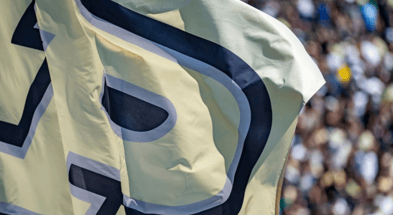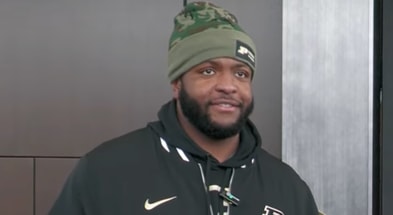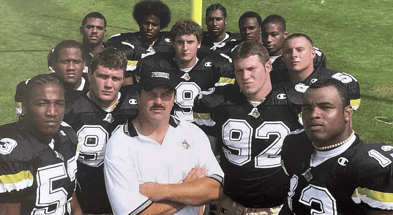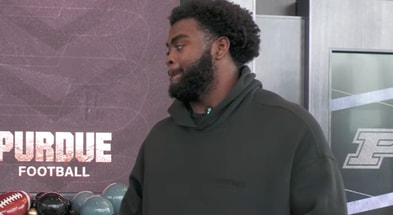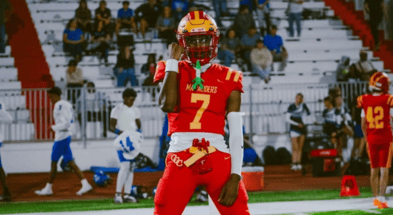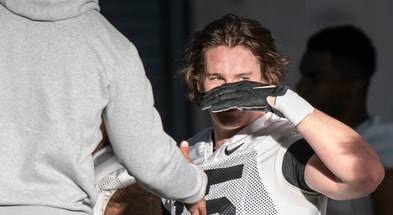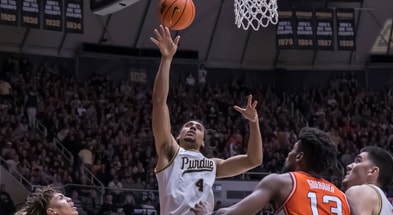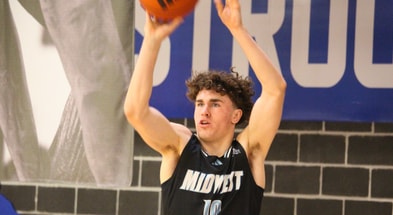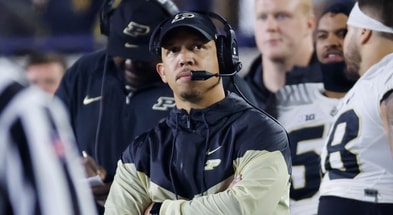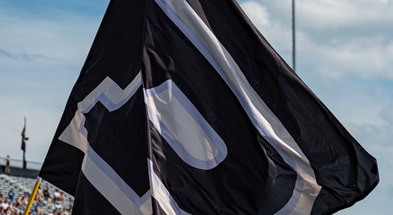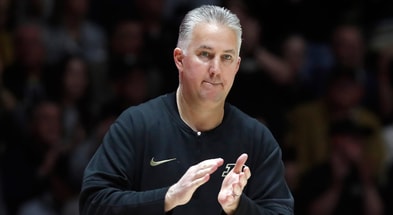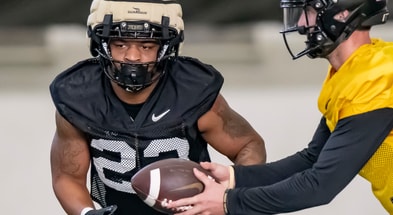Definite 2024 Men’s Hoops Prospectus 1.0
Coming off an NCAA runner-up season and winner of the past two Big Ten regular season titles, Purdue reboots starting next season post-Zach Edey. It does not figure to have to rebuild, as the Boilermaker program has every reason to expect its run of considerable success and stability to continue on.
The transfer portal window has come and gone, and Purdue’s roster appears more or less set, and so it’s time to take our first stab at projecting what Matt Painter and staff’s 2024-25 team might look like. Keep in mind, it’s only the start of May. New stuff will come to light.
First, a look at those on scholarship …
| Player | Year | Projected Position(s) |
| Caleb Furst | Senior | Forward/Center |
| Braden Smith* | Junior | Point Guard |
| Fletcher Loyer* | Junior | Shooting Guard/Wing |
| Trey Kaufman-Renn* | R-Junior | Center/Power Foward |
| Brian Waddell | R-Junior | Wing |
| Camden Heide* | R-Sophomore | Forward/Wing |
| Will Berg | R-Sophomore | Center |
| Myles Colvin* | Sophomore | Wing/Guard |
| Gicarri Harris | Freshman | Combo Guard/Wing |
| CJ Cox | Freshman | Combo Guard |
| Kanon Catchings | Freshman | Forward/Wing |
| Raleigh Burgess | Freshman | Center/Power Forward |
| Daniel Jacobsen | Freshman | Center |
| Jack Benter | Freshman | Shooting Guard/Wing |

THE PURDUE FRONTCOURT
There is no Zach Edey. And stalwart Mason Gillis is off to use his COVID year at Duke.
But there are still some real assets here.
Next in line to be the Boilermakers’ go-to low-post offensive player is Trey Kaufman-Renn, who spent his sophomore season playing forward after he was a center as a redshirt freshman. Does it matter which position he technically plays? Maybe defensively more than anything, but he’s getting the ball on offense either way. He has a chance to be one of the Big Ten’s — if not beyond’s — real breakout players next season, sliding into one of the plum roles in college basketball.
Kaufman-Renn started every game for Purdue this season, but Gillis wound up playing more minutes as part of a platoon. Nevertheless, he averaged 6.4 points in less than 17 minutes per game. Over 30 minutes, that would have been 11.3 points per game. Now that his offensive touches should increase exponentially, his numbers could erupt, but the new role will put under the microscope his foul shooting and passing and decision-making handling whatever defenses might try to throw at him.
He showed vibrant flashes this season of go-to-guy potential. Purdue often schemed to open second halves playing through him and often did so with great success. When Edey got in foul trouble early in the Big Ten season in a marquee game against Illinois, Kaufman-Renn scored 27 points.
TKR will present a different look from past Purdue post scorers, as he presents more face-up elements and can make threes. It will be different, but Purdue has all summer to construct an offense that suits him best. Kaufman-Renn did show some ability to play in pick-and-roll with Braden Smith, also, but the shoes to fill there will be enormous in more ways than one.
It remains to be seen who plays where in the Purdue frontcourt, as senior Caleb Furst and sophomore Will Berg and several incoming freshmen will have chances to have a say in things this summer. Furst fell out of the rotation in the NCAA Tournament, but does get his first chance at Purdue to really earn a critical role with off-season improvement and customized scheme. The towering Berg showed flashes in mop-up sort of playing time this season, but things are different when jumping from that role to something more. Big summer for him.
The likeliest scenario here might be for Purdue to use Kaufman-Renn as its center.
In which case, it could make a lot of sense to give wing Camden Heide a long look playing alongside him as Purdue’s “power” forward. His athleticism and ability to stretch the floor from that position — coupled with his legitimate size and strength — would be very different from what Purdue had at the 4 last season, but that could come with real advantages, both offensively and especially defensively, where Heide has shown he can guard 1 through 4. His interchangeability would be a real strength against offenses intent to hunt the 4 man in switches.
The freshmen will absolutely have a say in the frontcourt rotation, with 7-foot-3 center Daniel Jacobsen and versatile forwards Raleigh Burgess and Kanon Catchings coming in. Burgess is big, physical, energetic and skilled on the perimeter, assets that can be leveraged at either the 4 or 5. Catchings is immensely talented, a big-time shooter with athleticism, height and length, capable of playing as a stretch forward or towering wing. Jacobsen is massive, mobile and perimeter skilled.
Purdue will likely need at least one of these youngsters to play.
Regardless of who plays where and who plays how much, rebounding must endure, easier said than done without Edey and Gillis. It’s been one of Purdue’s most consistent formulaic strengths, especially on the offensive glass.
THE PURDUE BACKCOURT
Purdue has generally been known as a frontcourt program, and for good reason, even though All-American guards have come through West Lafayette.
Now, the guards take center stage.
Things change for Braden Smith now that Edey is gone — the duo shared a distinct synergy and unlocked so much in one another — but he may be the finest point guard in college basketball next season after a brilliant sophomore year, brought about in large part by him shifting to a more-scoring-minded mentality. The must here is for the weapons around Smith to get on the same page with him and elevate themselves to the level he inherently demands, be it overtly or not.
Classmate Fletcher Loyer has put together a really strong first two seasons at Purdue, but has done so more as an opportunist and complementary piece than anything. He will have the ball in his hands a lot this season to come and needed to not just score but facilitate and make offense flow. He may have to force things a bit more. What that would mean for his efficiency would remain to be seen. We’re speculating here. Loyer shot an impeccable 44.4 percent from three this season, 48.5 percent in Big Ten play, the face of Purdue’s astronomical improvement as a three-point-shooting team.
Lance Jones will be missed, creating a void newcomers will need to fill.
It will be up to freshmen to become depth. That’ll be on Gicarri Harris and/or CJ Cox. They’re both probably more combo guard-ish, but someone has to be Smith’s backup at point guard. Their physical maturity, shot-making track records and competitive, defensive-minded demeanors will be a good start, but that playbook is notoriously gigantic, so their acclimation will be one of the stories of the summer.
THE PURDUE WINGS
On the wing, it is Myles Colvin‘s time now. It was an up-and-down freshman season for Colvin, but Purdue pushed him into the deep end of the pool in the postseason and he stepped up. He’s ready for way more. He may be a prominent scorer for this team, but the story of his rookie year was the improvement he made defending and rebounding. That was the most important thing.
Purdue’s going to run plays for him early and often. He’s another prime breakout candidate, and highly likely to put in more than enough work this off-season to be ready.
Harris has multi-positional potential, as Heide obviously does, so moving parts exist here, too. This will be one of the most malleable rosters Matt Painter has had at Purdue.
Junior wing Brian Waddell gets another chance now, too, to crack the rotation. Things would be so much different for him right now had he not injured his knee during his redshirt season, completely knocking him off an upward trajectory just as Heide and Colvin were on their way.
Freshman Jack Benter is the consummate Purdue offensive piece, a good shooter, ball-handler and passer, but a player defined by a high basketball IQ and feel for offense. Those players almost always work at Purdue.
Should be interesting.
OFF-SEASON QUESTIONS AND KEYS
• Learn. Purdue will have as many as six freshmen coming in June. There’s no way around any class that big having to contribute right away.
It’s an inflection point here between the diverging philosophies in program-building in college basketball right now. It would not be entirely accurate to call Purdue “young” — but it will rely on some young players while much of the Big Ten has spent the spring once again hoarding 23-year-olds, who may or may not coalesce smoothly.
• Braden Smith. This summer is going to be big for Smith gelling with some new go-to running mates. Is that Trey Kaufman-Renn in pick-and-roll the same way it was Zach Edey? Hard to know. The players are very different. How about Camden Heide?
Part of the reason Purdue’s offense was so good this past season is that the intricacies of its massive playbook were executed very well, but also the Boilermakers could always fall back on very simple offense that was just as formidable as the complex stuff.
• Leadership. This shouldn’t be an issue at all, but we’ve been wrong before on this (ahem, 2020). Smith, Loyer and Kaufman-Renn are a great start, experienced and competitive, but it is very important for the intangibles that yielded this past season’s consistency and professionalism be passed down to all these new guys and for certain standards to be upheld.
• Scheme. Purdue made profound changes last season and hit home runs. This year there’s no way around them having to tweak some things on defense and obviously build an offensive playbook around some different dynamics.
• Redshirts. This won’t be a front-burner issue ’til fall, but there’s simply no way that this six-man freshman class stays a six-man class. Purdue’s title-game run validated that redshirting in the Modern Era still works. Expect at least one, maybe two. It won’t be decided in the summer, but impressions add up.
It should be noted too that Purdue is currently one over the limit of 13 scholarships. That will have to be sorted out before the start of the fall semester.
